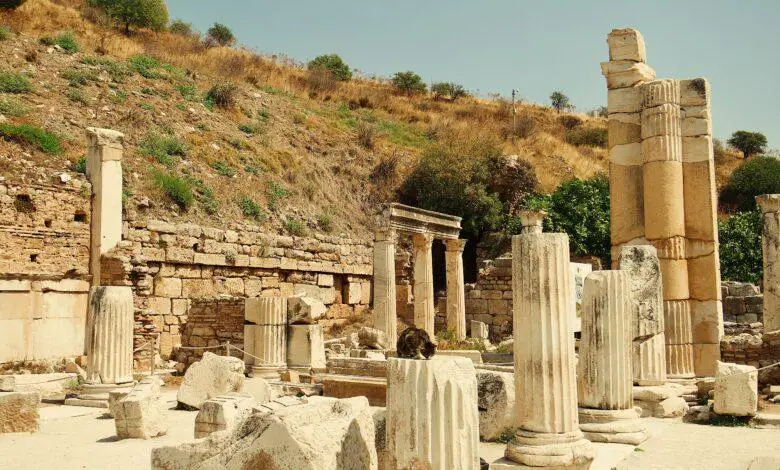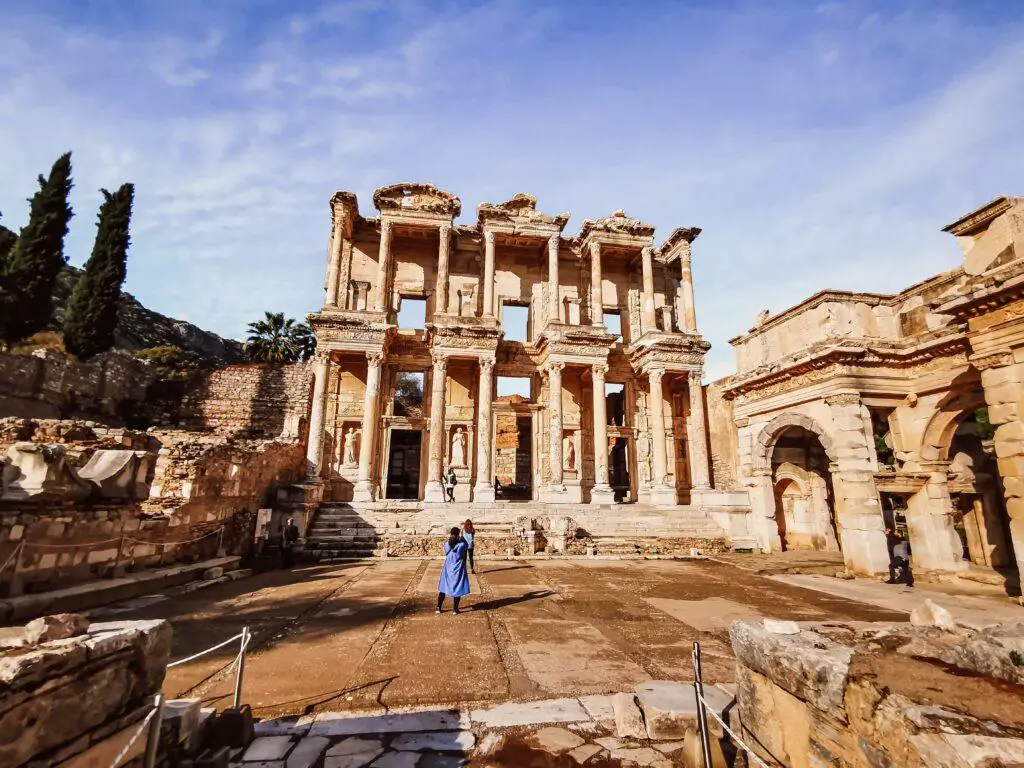The Ancient City of Ephesus, Turkey 🏛️: Ruins and History
Unveiling the Timeless Beauty and Heritage of Ephesus

Introduction
Nestled along the scenic coast of modern-day Turkey lies a place where history and time have melded into an awe-inspiring spectacle. Welcome to the ancient city of Ephesus, a treasure trove of ruins and a testament to human civilization’s progress. In this blog post, we’ll embark on a journey through time, exploring the rich history and captivating remnants of this remarkable city. Ephesus, with its grandeur and significance, has the power to transport you back to a world where emperors walked, philosophers pondered, and gods were worshipped. Join us as we uncover the secrets of Ephesus, from its inception to its present-day allure.
Historical Background
The history of Ephesus, an ancient city located in present-day Turkey, is rich and varied. Ephesus is believed to have been founded by Ionian Greeks around 3000 BC. Over the centuries, it evolved into a thriving and influential city in the ancient world. The city’s strategic location near the coast of Asia Minor (modern-day Turkey) made it a hub for trade, culture, and civilization. Ephesus was also famous for its Temple of Artemis, one of the Seven Wonders of the Ancient World.
Hellenistic and Roman Periods
During the Hellenistic period, Ephesus continued to flourish and became an important center for learning, philosophy, and art. It was under Roman rule, however, that Ephesus truly reached its zenith. The city’s prosperity can be attributed to its strategic location along the Roman trade routes. Notable structures like the Library of Celsus, the Great Theater, and the Temple of Artemis were built during this time. Ephesus was not only a major trading and economic center but also a hub of religious activity.
Decline and Abandonment
The decline of Ephesus began in the late Roman period, as the harbor silted up, limiting its access to the sea and diminishing its significance as a trade hub. In the 3rd century AD, the city was struck by a series of devastating earthquakes, which caused significant damage to its architectural marvels. The decline continued during the Byzantine era, as the city was frequently threatened by invasions and lost its political and economic importance.
By the 15th century, Ephesus was largely abandoned, with its inhabitants relocating to other places. The city’s ruins gradually became buried under layers of silt, soil, and vegetation. Today, Ephesus stands as an archaeological site, a window into the past, showcasing the grandeur of its Hellenistic and Roman past. It is a UNESCO World Heritage Site and a popular tourist destination, attracting visitors from around the world who come to admire its well-preserved remnants and understand the legacy of this once-mighty city.
Key Attractions
Ephesus, the ancient city in Turkey, boasts a plethora of key attractions that offer a glimpse into its rich history and architectural grandeur. From the Library of Celsus to the Temple of Artemis, each site carries its unique significance, making Ephesus a must-visit destination for history enthusiasts and curious travelers alike.
The Library of Celsus
One of the most iconic structures in Ephesus, the Library of Celsus, stands as a testament to the city’s cultural and intellectual achievements during the Roman period. Built in the 2nd century AD, this library was a repository of knowledge, housing thousands of scrolls. The façade, adorned with statues and intricate carvings, showcases the architectural brilliance of the time.
The Great Theatre
Ephesus’s Great Theatre is an awe-inspiring relic from antiquity, capable of seating an astounding 25,000 spectators. This remarkable structure was not only a venue for theatrical performances but also hosted events, gladiatorial contests, and political assemblies. The acoustics of the theater are so exceptional that even a whisper on the stage can be heard in the farthest seats, a testament to the advanced engineering skills of its time.
The Temple of Artemis
The Temple of Artemis, one of the Seven Wonders of the Ancient World, was a sacred place dedicated to the goddess Artemis. Unfortunately, little remains of this grand temple today, but its historical significance is undeniable. Visitors can explore the site and its history, understanding the profound religious devotion of the people of Ephesus.
The Terrace Houses
The Terrace Houses, also known as the “Houses of the Rich,” provide a unique opportunity to glimpse into the daily lives of Ephesian elites. These well-preserved houses feature exquisite mosaics, frescoes, and architectural details that showcase the opulence and craftsmanship of the period. Visitors can appreciate the beauty and luxury of these ancient residences.
The Agora
The Agora, or marketplace, was the bustling heart of Ephesus, where commerce, politics, and social life converged. It was a vibrant space filled with shops, administrative buildings, and communal spaces. Exploring the Agora allows visitors to picture the daily life and interactions of the city’s inhabitants.
The Temple of Hadrian
Dedicated to the Roman Emperor Hadrian, this temple is renowned for its intricate facade, featuring elegant Corinthian columns and detailed reliefs. It’s a striking example of Roman architecture and the importance of imperial patronage in ancient Ephesus.

Notable Features
Ephesus, an ancient city with a storied past, is replete with notable features that continue to captivate visitors from around the world. Among its most remarkable attributes is its ancient architecture. The city’s well-preserved structures, from grand theaters to intricate temples, offer a breathtaking glimpse into the architectural prowess of antiquity. Ephesus showcases an array of architectural styles, reflecting the influences of various civilizations that once inhabited or controlled the city, including the Greeks, Romans, and Byzantines. The meticulous design and craftsmanship of these edifices, from the Library of Celsus to the Temple of Hadrian, serve as a testament to the city’s cultural and artistic achievements.
The Role of Ephesus in the Spread of Christianity
Ephesus holds a special place in Christian history, as it was one of the key centers for the spread of early Christianity. The city is notably mentioned in the Bible, particularly in the Book of Ephesians. It is believed that the apostle Paul spent a considerable amount of time in Ephesus, where he preached and established Christian communities. The House of the Virgin Mary, located nearby, is a site of Christian pilgrimage, as it is said to be the place where Mary, the mother of Jesus, spent her later years. The ancient Basilica of St. John, built to honor the apostle John, is another Christian landmark in Ephesus. Visiting these sites allows pilgrims and history enthusiasts to connect with the early Christian roots of the city.
The Significance of the Ephesian Artemis
The Temple of Artemis, dedicated to the goddess of hunting and wilderness, Artemis, was a prominent religious center in Ephesus and one of the Seven Wonders of the Ancient World. Artemis was a multifaceted deity, representing fertility, childbirth, and the protection of women. The temple itself was an architectural marvel, housing a sacred statue of Artemis that was believed to have fallen from the heavens. The Ephesian Artemis was distinct from other depictions of the goddess, with multiple rows of breasts adorning her chest, symbolizing her nurturing and protective nature.
Understanding the significance of the Ephesian Artemis helps visitors appreciate the cultural and religious diversity of ancient Ephesus. The temple was a destination for pilgrims and a symbol of the city’s religious devotion. Today, while the temple is mostly in ruins, it remains a compelling historical and archaeological site, offering insights into the spiritual world of ancient Ephesus.
Preservation and Restoration
Preserving the historical and architectural treasures of Ephesus is of paramount importance to ensure that future generations can continue to explore and appreciate its rich heritage. The site faces numerous challenges, including natural wear and tear, environmental factors, and the impact of tourism. To combat these issues, extensive efforts have been undertaken to safeguard Ephesus.
Conservationists and archaeologists have implemented a range of preventive measures, such as protective roofing to shield structures from the elements and ongoing maintenance to repair and stabilize deteriorating features. These measures aim to strike a balance between allowing visitors to experience the site’s splendor and safeguarding its delicate remains.
Ongoing Restoration Projects
Ephesus is a living archaeological site, with ongoing restoration projects designed to further unveil its hidden treasures. Skilled teams of archaeologists and conservators work tirelessly to meticulously restore and rehabilitate sections of the city. One such noteworthy project is the ongoing restoration of the Temple of Artemis, an endeavor that seeks to recreate some of the temple’s original glory while preserving its historical authenticity.
Additionally, the Terrace Houses, known as the “Houses of the Rich,” have been a focus of extensive restoration efforts. These opulent residences, once inhabited by Ephesus’s elite, feature stunning mosaics and frescoes. Restoration work aims to bring these houses back to life, allowing visitors to appreciate their former grandeur.
The restoration and preservation of Ephesus extend beyond structural elements. Archaeological excavations continue to uncover new artifacts and historical insights. These ongoing efforts ensure that the site remains a dynamic and ever-evolving window into the past.
By including information about the preservation measures in place and ongoing restoration projects in your article, you can emphasize the commitment to safeguarding Ephesus’s heritage while also highlighting the exciting prospects for future exploration and discovery at this captivating historical site.
FAQs
Q: How can I reach Ephesus?
A: Ephesus is located near Selçuk in Turkey and is easily accessible by car, bus, or train.
Q: What is the best time to visit Ephesus?
A: The best time to visit is during the spring or fall when the weather is mild and pleasant.
Q: Are guided tours available at Ephesus?
A: Yes, guided tours are available and recommended to fully understand the historical and archaeological significance of the site.
Q: Can I take photographs at Ephesus?
A: Yes, you are allowed to take photographs, but the use of tripods is usually restricted.
Q: Is there an entrance fee to Ephesus?
A: Yes, there is an entrance fee to visit the archaeological site.
Q: What other attractions are there in the vicinity of Ephesus?
A: Nearby attractions include the Ephesus Museum, the House of the Virgin Mary, and the Temple of Artemis.
Conclusion
Ephesus, the jewel of ancient Anatolia, beckons to all who seek to explore the layers of history buried beneath its ruins. As we conclude our journey through this once-thriving city, we are left with a profound appreciation for the rich tapestry of human history. Ephesus is not just a place where time stands still; it’s a place where time speaks to us, whispering stories of empires, beliefs, and the passage of countless lives.
The ancient city of Ephesus has endured the test of time, and its significance transcends the ages. It’s a destination where the past comes to life, where the ruins tell stories, and where visitors can connect with the people who once called this place home. Whether you’re a history enthusiast, an architecture buff, or a curious traveler, Ephesus promises an unforgettable experience.
So, make a date with history, and plan your visit to Ephesus, Turkey. Wander through its cobbled streets, stand in the shadow of the Library of Celsus, and let the echoes of ancient footsteps guide your exploration. Ephesus, with its ruins and history, will leave an indelible mark on your heart and soul, a testament to the enduring spirit of human civilization.
UP NEXT
https://touristeyes.com/a-trip-to-the-top-exploring-the-swiss-alps/





Facebook Comments